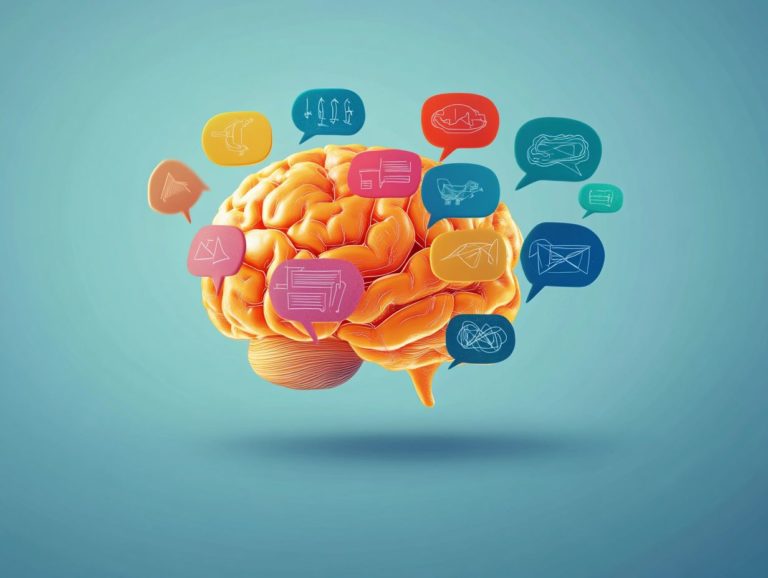How Movies Can Help You Learn a Language
Movies transcend mere entertainment; they are great tools for learning a language.
By immersing yourself in films, you indulge in captivating narratives while also elevating your language skills in an enjoyable and engaging way.
This article explores why movies are effective for language acquisition, guides you on selecting the right films based on cultural relevance and proficiency, and presents various techniques to optimize your learning experience.
We will also cover the benefits and challenges you may face on this journey. Transform your language-learning adventure with the enchanting world of cinema!
Contents
- Key Takeaways:
- The Role of Movies in Language Learning
- Choosing the Right Movies for Language Learning
- How to Use Movies for Language Learning
- Benefits of Learning a Language Through Movies
- Potential Challenges and How to Overcome Them
- Frequently Asked Questions
- How can movies help you learn a new language?
- What types of movies are best for language learning?
- Can you really learn a language just by watching movies?
- How can you use movies to improve your speaking skills in a new language?
- Are there specific techniques for watching movies to learn a language?
- Can watching movies in a new language help with cultural understanding?
Key Takeaways:

Movies are effective tools for language learning because they immerse learners in a language and culture. When choosing films, consider cultural relevance and language proficiency to maximize learning outcomes. Different techniques, like subtitles and repetition, can enhance your language learning experience while watching movies.
The Role of Movies in Language Learning
Movies serve as a powerful catalyst in your language learning journey. They offer immersive experiences through visual storytelling, familiar expressions, and rich cultural contexts.
Incorporating dialogues from various genres such as comedies, action films, or foreign cinema enhances your vocabulary, pronunciation, and reading skills.
The blend of visual cues and audio elements aids comprehension and transforms movies into invaluable resources for language immersion.
This is particularly true for children’s films or Netflix Originals, which provide engaging content designed to hold your attention while you learn.
Why Movies are Effective Tools for Language Learning
Movies are excellent tools for your language learning journey. They blend engaging storytelling, rich dialogues, and diverse cultural contexts, making the process educational and entertaining.
This immersive format allows you to practice language skills in ways that resonate with you. As you dive into these narratives, you encounter authentic conversational patterns that enhance your comprehension.
Children s movies, for example, feature simple dialogues and clear contexts, making them great for introducing a new language and helping you grasp essential vocabulary and phrases.
In contrast, foreign films invite you to explore deeper cultural nuances and phrases that have meanings different from the literal meanings of the individual words.
By engaging with a variety of genres, you naturally expand your vocabulary and solidify your understanding of the target language while enjoying the magic of cinema.
Choosing the Right Movies for Language Learning
Selecting the right movies for language learning is essential.
Choosing films that match your language proficiency and cultural interests can significantly elevate your learning experience and ensure effective exposure to the language.
This thoughtful approach makes the process enjoyable and enriches your understanding of the language in a meaningful context.
Cultural Relevance and Language Proficiency
Cultural relevance plays a pivotal role when selecting movies for language learning. It ensures the content resonates with your interests and aligns with your proficiency, transforming the learning experience into something engaging and effective.
For example, a learner keen on Spanish may find contemporary films like “Coco” incredibly beneficial. These movies highlight linguistic nuances and provide rich cultural insights that enhance understanding, making it easier to connect vocabulary to real-life situations.
Finding the right balance is crucial; overly complex plotlines or advanced dialogue can lead to frustration. By choosing films that present just the right level of challenge, educators can foster a positive and productive learning environment that boosts confidence.
How to Use Movies for Language Learning

Using movies for language learning opens up a world of possibilities through a range of techniques and strategies that elevate your language practice.
Try out adjusting audio settings, experimenting with subtitles, and incorporating fun activities to foster a deeper connection with the content.
Each approach enriches your experience, making language acquisition not just effective, but also enjoyable.
Techniques and Strategies
There are numerous techniques and strategies at your disposal for using movies as effective language learning tools.
Consider watching small parts of a movie, which allows you to focus on specific dialogues and reinforce your exposure to the language.
By incorporating captions that you can interact with, you can effortlessly connect spoken dialogue with written text, enriching your vocabulary and sharpening your pronunciation.
Pausing during significant moments gives you a chance to practice vocabulary and encourages you to reflect on key phrases and cultural nuances presented in the film.
Engaging in discussions about show summaries with your language learning partners cultivates a collaborative atmosphere where ideas and interpretations can be exchanged, deepening your understanding.
These methods enhance your listening skills and contribute to your overall comprehension, transforming the experience into something enjoyable and educational.
Benefits of Learning a Language Through Movies
Learning a language through movies provides a wealth of benefits, such as improved listening comprehension, enhanced vocabulary acquisition, and a deeper cultural understanding.
Each film becomes a rich tapestry, helping you cultivate well-rounded language skills that extend beyond the classroom.
Improved Listening and Comprehension Skills
One of the primary benefits of learning a language through movies is the remarkable enhancement of your listening and comprehension skills.
You ll find yourself immersed in authentic dialogues and a variety of accents within engaging narratives.
This exciting experience allows you to understand different speech patterns and pronunciations that traditional classroom settings might overlook.
By surrounding yourself with diverse linguistic environments, you’ll grasp the subtle nuances in speech that make a world of difference.
To boost your understanding and retention, consider using subtitles in the target language. This approach helps you connect spoken words with their written forms seamlessly.
Repeating dialogues reinforces your familiarity with pronunciation and intonation while sharpening your focus on high-frequency words, essential for building a robust vocabulary for everyday conversations.
Enhanced Vocabulary and Grammar
Through exposure to rich dialogues and captivating storylines, movies can significantly enhance your vocabulary and grammar skills.
You ll encounter familiar expressions and high-frequency words in context.
Films often present a variety of speech patterns and colloquial phrases that you might not come across in traditional classroom settings.
This authentic exposure aids in acquiring new vocabulary and reinforces your understanding of grammatical structures, as you hear how native speakers use words naturally.
By engaging with language in dynamic scenarios, you can forge mental connections that facilitate retention.
This immersive experience fosters a deeper comprehension of nuances, idioms, and cultural subtleties, leading to a more well-rounded grasp of the language as a whole.
Increased Cultural Understanding

One of the key benefits of learning a language through movies is the enhanced cultural understanding they offer. Films serve as a window into cultural nuances, traditions, and social dynamics of the language’s context.
This immersive experience enables you to engage with authentic dialogues and scenarios, making it easier to grasp idiomatic expressions and colloquialisms. Take, for instance, films like “Am lie,” which not only entertain with whimsical storytelling but also invite you to explore French customs, cuisine, and the art of caf culture.
Similarly, the Mexican film “Coco” sheds light on the significance of the Day of the Dead. This fosters a deeper appreciation for its role in familial and cultural identity. These examples show how fun and effective blending language with culture can be through culturally rich narratives.
Potential Challenges and How to Overcome Them
Movies are effective for language learning, but challenges may arise. Understanding different accents can be tough, and grasping slang and idioms might pose additional hurdles that affect your comprehension and engagement.
Dealing with Dialects and Accents
Dealing with dialects and accents in movies can present unique challenges for language learners. Variations in pronunciation and regional expressions can significantly influence overall comprehension and listening skills.
To navigate these linguistic nuances, choose films from diverse regions that highlight a broad spectrum of accents and speech styles. For example, immersing yourself in a blend of British, Australian, and American films can expose you to various pronunciations and colloquialisms.
Engaging with content featuring a variety of characters allows you to appreciate how dialects can alter both the meaning and tone of conversations. Enhancing listening skills may involve active practices, such as pausing scenes to repeat phrases or selectively using subtitles to improve clarity and reinforce understanding over time.
Understanding Slang and Idioms: Why They Matter
Understanding slang and idioms in movies is essential for language learners, as these expressions often mirror cultural nuances that enhance overall comprehension and vocabulary practice. Slang refers to informal words and phrases used in specific contexts, while idioms are expressions whose meanings aren’t deducible from the individual words.
This is particularly relevant because films frequently portray everyday conversations, showcasing vibrant language characters use in various contexts.
From iconic phrases like “break a leg,” meaning “good luck,” to contemporary expressions shaped by pop culture, movie dialogues offer a treasure trove for your learning journey. These idioms not only improve comprehension but also provide valuable insights into social interactions and cultural values.
If you re eager to broaden your understanding, resources such as online dictionaries, language learning apps, and dedicated websites for slang can be incredibly beneficial. They enable you to explore the colorful world of language more deeply.
Frequently Asked Questions
How can movies help you learn a new language?

Movies can help you learn a new language by exposing you to the language in a natural and authentic context. This can improve your listening and comprehension skills, as well as your vocabulary and grammar.
What types of movies are best for language learning?
Movies with simple and clear dialogue, subtitles in your native language, and visuals that support the dialogue are great for language learning. It’s also helpful to choose movies that you are interested in and enjoy watching.
Can you really learn a language just by watching movies?
While watching movies alone may not be enough to become fluent in a language, it can be a valuable tool in your language learning journey. It’s important to supplement movie-watching with other language learning activities, such as studying grammar and practicing speaking.
So, why not take a step today? Watch a movie in your target language and immerse yourself in the cultural richness it offers!
How can you use movies to improve your speaking skills in a new language?
One effective method is to watch a scene and repeat it out loud. Mimic the pronunciation and intonation of the actors.
You can pause the movie and practice speaking along with the characters to build confidence.
Are there specific techniques for watching movies to learn a language?
One technique is watching the movie with subtitles in your target language. Then, re-watch it with subtitles in your native language to reinforce vocabulary.
Also, consider watching the same movie multiple times. Focus on different aspects, like listening comprehension or specific vocabulary, each time.
Can watching movies in a new language help with cultural understanding?
Yes! Movies expose you to both the language and the culture of the region where it s spoken.
You ll learn about customs, traditions, and everyday life through characters and storylines. This dramatically enhances your understanding and appreciation of both the language and its culture.






